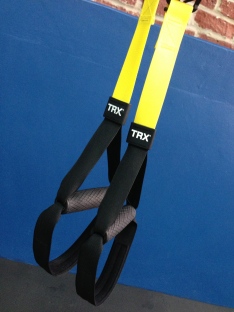
Suspension Training 101
 You’ve probably seen the black and yellow “straps” hanging in your gym or, if you live in San Francisco, you’re just as likely to have seen them anchored to a stop sign at a busy intersection. Developed by former Navy Seal and Stanford graduate Randy Hetrick, TRX is a San Francisco-based company that is sweeping the nation with a new form of fitness training. Used in the military and found worldwide in professional sports team training facilities, TRX Suspension Training is a tool that allows individuals to use their own body weight to develop strength, stability and flexibility.
You’ve probably seen the black and yellow “straps” hanging in your gym or, if you live in San Francisco, you’re just as likely to have seen them anchored to a stop sign at a busy intersection. Developed by former Navy Seal and Stanford graduate Randy Hetrick, TRX is a San Francisco-based company that is sweeping the nation with a new form of fitness training. Used in the military and found worldwide in professional sports team training facilities, TRX Suspension Training is a tool that allows individuals to use their own body weight to develop strength, stability and flexibility.
TRX can be used to make exercises more challenging by adding instability to a movement, make exercises more manageable by assisting the movement, and allows participants to work multiple areas of the body in all planes of movement. By simply adjusting your body position, you can change the resistance of an exercise, and control how challenging the workout is. But before you start thinking TRX is only for the elite athlete, read on…
I have been working as part of the TRX team for over two years, originally as a client. I knew of the product and even had one in the clinic where I worked, but it wasn’t until a patient told me that his goal for physical therapy was to get back to using his TRX that I started to wonder how it might be beneficial for my clients. A case of perfect timing, TRX was just releasing their Sports Medicine Suspension Training Course for healthcare practitioners and I was asked to become an instructor. Over the past two years I have presented the one day course around the country and have had the opportunity to meet and engage with some of the best and brightest in the rehabilitation and fitness industries.
While TRX is not the only tool I use in my treatments, I can’t think of any client for whom it would be inappropriate. So why exactly do I use TRX in my practice? TRX is a tool that allows me to:
- Teach proper movement
- Assist movement that a client might otherwise have difficulty performing
- Unload healing bones, joints, ligaments, tendons, and muscles during the rehab process
- Combine balance, stability and strength work into challenging full body exercises.
- Provide a workout to the entire body during the rehab process
- Save space and improve compliance due to easy set up and portability
If you would like to learn more about how TRX might be useful in your rehabilitation or are looking for a new form of exercise contact us today!
415.765.1502
info@therapydiasf.com
